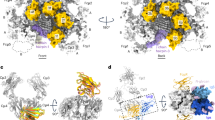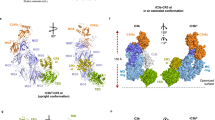Abstract
Antibody-dependent cell-mediated cytotoxicity plays an important role in the macrophage-mediated destruction of target cells. While the selectivity is based on antibody specificity, the lytic attack is triggered by Fc receptor–mediated respiratory burst. To mimic IgG opsonization, a chimeric antibody-like molecule, containing human IgG1 Fc, was expressed on the surface of mammalian cells. The transmembrane domain of the human transferrin receptor was fused in-frame to the N-terminus of the second and third domains of human IgG1 heavy-chain constant region. This fusion molecule was designed to take advantage of the type II membrane anchor property of the transferrin receptor to express the Fc portion of the molecule in a reverse orientation, such that the Fc portion projected away from the cell surface. This is in contrast to the conventional cell surface IgG, which is anchored by a C-terminal type I transmembrane domain. The cell surface expressed reverse Fc no longer activated complement, but retained Fc receptor–binding capability and activated superoxide production by macrophages. This activity was completely blocked by an FcγR I–specific monoclonal antibody.
This is a preview of subscription content, access via your institution
Access options
Subscribe to this journal
Receive 12 print issues and online access
$209.00 per year
only $17.42 per issue
Buy this article
- Purchase on Springer Link
- Instant access to full article PDF
Prices may be subject to local taxes which are calculated during checkout





Similar content being viewed by others
References
Raghavan, M. and Bjorkman, P.J. 1996 Fc receptors and their interactions with immunoglobulins. Annu. Rev. Cell Dev. Biol. 12: 181–220.
Miller, K.L., Duchemin, A.M., and Anderson, C.L. 1996 A novel role for the Fc receptor gamma subunit: enhancement of Fc gamma R ligand affinity. J. Exp. Med. 183: 2227–2233.
Allen, L.A. and Aderem, A. 1996 Molecular definition of distinct cytoskeletal structures involved in complement-and Fc receptor-mediated phagocytosis in macrophages. J. Exp. Med. 184: 627–637.
Durden, D.L., Rosen, H., Michel, B.R., and Cooper, J.A. 1994 Protein tyrosine phosphatase inhibitors block myeloid signal transduction through the Fc gamma RI receptor. Exp. Cell Res. 211: 150–162.
Hulett, M.D. and Hogarth, P.M. 1994 Molecular basis of Fc receptor function. Adv. Immunol. 57: 69–74.
Adams, D.O. and Hamilton, T.A. 1984 The cell biology of macrophage activation. Annu. Rev. Immunol. 2: 283–318.
Somers, S.D. and Adams, D.O. 1986 Enhancement of selective tumor cell binding by activated murine macrophages in response to phorbol myristate acetate. J. Immunol. 136: 2323–2332.
Adams, D.O. and Koren, H.S. 1979 BCG-activated macrophages: comparison as effectors in direct tumor-cell cytotoxicity and antibody dependent cell-mediated cytotoxicity. Adv. Exp. Med. Biol. 121B: 195–201.
Nathan, C.F. 1983 Reactive oxygen intermediates in lysis of antibody-coated tumor cells, pp. 199–215 in Macrophage-mediated antibody dependent cellular cytotoxicity. Koren, H.S. (ed.), Marcel Dekker, New York.
Johnson, W.J., Steplewski, Z., Koprowski, H., and Adams, D.O. 1985 Destructive interactions between murine macrophages, tumor cells, and antibodies of the IgG2a isotype. Adv. Exp. Med. Biol. 184: 75–80.
Johnson, W.J., Steplewski, Z., Matthews, T.J., Hamilton, T.A., Koprowski, H., and Adams, D.O. 1986 Cytolytic interactions between murine macrophages, tumor cells, and monoclonal antibodies: characterization of lytic conditions and requirements for effector activation. J. Immunol. 136: 4704–4713.
Lowrie, D.B. and Andrew, P.W. 1988 Macrophage antimycobacterial mechanisms. Br. Med. Bull. 44: 624–634.
Zerial, M., Melancon, P., Schneider, C., and Garoff, H. 1986 The transmembrane segment of the human transferrin receptor functions as a signal peptide. EMBO J. 5: 1543–1550.
Schneider, C. and Williams, J.G. 1985 Molecular dissection of the human transferrin receptor. J. Cell Sci. Suppl. 3: 139–149.
Burger, R., Zilow, G., Bader, A., Friedlein, A., and Naser, W. 1988 The C terminus of the anaphylatoxin C3a generated upon complement activation represents a neoantigenic determinant with diagnostic potential. J. Immunol. 141: 553–558.
Mollnes, T.E., Garred P., and Bergseth, G. 1988 Effect of time, temperature and anticoagulants on in vitro complement activation: consequences for collection and preservation of samples to be examined for complement activation. Clin. Exp. Immunol. 73: 484–488.
Hugli, T. E and Chenoweth, D.E. 1980 Biologically active peptides of complement. Techniques and significance of C3a and C5a measurements, pp. 443 in Laboratory and research methods in biology and medicine. Nakamura, R. Dito, WR., and Tucher, ES. (eds.), Alan R. Liss, New York.
Knarr, G., Gething, M.J., Modrow, S., and Buchner, J. 1995 BiP binding sequences in antibodies. J. Biol. Chem . 270: 27589–27594.
Canfield, S.M. and Morrison, S.L. 1991 The binding affinity of human IgG for its high affinity Fc receptor is determined by multiple amino acids in the CH2 domain and is modulated by the hinge region. J. Exp. Med. 173: 1483–1491.
Klein, M., Haeffner-Cavaillon, N., Isenman, D.E., Rivat, C., Navia, M.A., Davies, D.R. et al. 1981 Expression of biological effector functions by immunoglobulin G molecules lacking the hinge region. Proc. Natl. Acad. Sci. USA 78: 524– 528.
Jing, S.Q. and Trowbridge, I.S. 1987 Identification of the intermolecular disulfide bonds of the human transferrin receptor and its lipid-attachment site. EMBO J. 6: 327–331.
Schumaker, V.N., Calcott, M.A., Spiegelberg, H.L., and Muller-Eberhard, H.J. 1976 Ultracentrifuge studies of the binding of IgG of different subclasses to the C1q subunit of the first component of complement. Biochemistry 15: 5175–5181 .
Humphrey, J.H. and Dourmashkin, R.R. 1969 The lesions in cell membranes caused by complement. Adv. Immunol. 11: 75–115.
Tan, L.K., Shopes, R.J., Oi, V.T., and Morrison, S.L. 1990 Influence of the hinge region on complement activation, C1q binding, and segmental flexibility in chimeric human immunoglobulins. Proc. Natl. Acad. Sci. USA 87: 162–166.
Richards, S.A., Lounsbury, K.M., Carey, K.L., and Macara, I.G. 1996 A nuclear export signal is essential for the cytosolic localization of the Ran Binding Protein, RanBP1. J.Cell Biol. 134: 1157–1168.
Margulies, D.H. 1994 Direct cellular ELISA to detect cell-surface antigens, pp. 2.1.13 inCurrent protocols in immunology, Vol. 1. Coligan, J.E. Kruisbeek, A.M., Margulies, D.H., Shevach, E.M., and Strober, W. (eds.), John Wiley & Sons, New York.
Johnston, P.A., Adams, D.O., and Hamilton, T.A. 1985 Regulation of the Fc-receptor-mediated respiratory burst: treatment of primed murine peritoneal macrophages with lipopolysaccharide selectively inhibits H2O2 secretion stimulated by immune cpmlexes. J. Immunol. 135: 513–518.
Tao W., Corbett, M.J., and Pickett, W. 1995 Monomeric bovine IgG2 is a potent stimulus for bovine neutrophils. J. Leukoc. Biol. 58: 203–208.
Acknowledgements
The authors thank William F. Hickey, James R. Dasch, Paul A. Johnston, Edward E. Baetge, and Joseph P. Hammang for helpful discussions, and Paula M. Krueger and Jennifer Jackson for their technical assistance. The authors also thank Mark D. Lindner for critical reading of the manuscript.
Author information
Authors and Affiliations
Corresponding author
Rights and permissions
About this article
Cite this article
Stabila, P., Wong, S., Kaplan, F. et al. Cell surface expression of a human IgC Fc chimera activates macrophages through Fc receptors. Nat Biotechnol 16, 1357–1360 (1998). https://doi.org/10.1038/4339
Received:
Accepted:
Issue Date:
DOI: https://doi.org/10.1038/4339
This article is cited by
-
Modular assembly of synthetic proteins that span the plasma membrane in mammalian cells
BMC Biotechnology (2016)
-
Evaluation of Two Internalizing Carcinoembryonic Antigen Reporter Genes for Molecular Imaging
Molecular Imaging and Biology (2011)
-
Surface display of IgG Fc on baculovirus vectors enhances binding to antigen-presenting cells and cell lines expressing Fc receptors
Archives of Virology (2009)
-
Stable expression of chimeric anti-CD3 receptors on mammalian cells for stimulation of antitumor immunity
Cancer Gene Therapy (2003)
-
Evaluation of blood compatibility of fluorinated polyimide by immunolabeling assay
Journal of Artificial Organs (2001)



